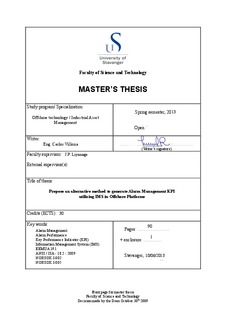| dc.contributor.author | Villoria Yepez, Carlos Rafael | |
| dc.date.accessioned | 2013-09-23T12:44:17Z | |
| dc.date.available | 2013-09-23T12:44:17Z | |
| dc.date.issued | 2013-06-12 | |
| dc.identifier.uri | http://hdl.handle.net/11250/182924 | |
| dc.description | Master's thesis in Offshore technology | no_NO |
| dc.description.abstract | Weaknesses regarding alarm management practices have been
recognized as partial causes of plant incidents with tragic results, for
example the Texas City Oil Refinery explosion in 2005. Necessity in alarm
regulation was recognized by industry bodies and norms were created
(EEMUA 119, ANSI/ISA 18.2) in order to address this. These norms define
a complete alarm management lifecycle, including the definition of an
alarm performance monitoring process with the supervision of alarm’s key
performance indicators (KPI)
Alarm KPI generation in oil instalations is a complex technological task
and generally includes the integration of alarms coming from different
sources in the process plant. The Information Management Systems (IMS)
as defined in NORSOK I-002 as the natural gathering engine for process
data in an offshore installation. The utilization of IMS in Alarm
Management Purposes is included in this NORSOK standard.
The original driver of this investigation was that Offshore Platforms in the
Norwegian Continental Shelf do not utilize IMS for Alarm Management KPI
generation, despite their intense utilization of IMS for other purposes.
Technical reasons for this practice are not known. In order to evaluate the current capacity of IMS in alarm KPI generation, a
minimum required set of KPIs was established although different
standards show variations between KPIs. The data structure gathered
inside IMS in related to alarms (alarms metadata) was compared against
the established set of KPIs. The main study finding conclude that data
contained whiting the IMS structure is currently not enough for generate
the priority- related KPIs, mainly because alarm priority is not included in
current IMS.
In general terms; IMS data structure is not defined by NORSOK and even
when included in some industry related regulations (as Statoil TR2258)
Alarm Priority is not considered to be part of Alarm metadata.
The above finding points to an easy solution and raises questions
regarding lack of “data priority” in the IMS data structure. This comes from
a lack of regulation in IMS Implementation, mainly because of NORSOK
standards. | no_NO |
| dc.language.iso | eng | no_NO |
| dc.publisher | University of Stavanger, Norway | no_NO |
| dc.relation.ispartofseries | Masteroppgave/UIS-TN-IKM/2013; | |
| dc.subject | alarm management | no_NO |
| dc.subject | alarm performance | no_NO |
| dc.subject | key performance indicators | no_NO |
| dc.subject | KPI | no_NO |
| dc.subject | information management system | no_NO |
| dc.subject | IMS | no_NO |
| dc.subject | EEMUA 191 | no_NO |
| dc.subject | ANSI/ISA 18.2-2009 | no_NO |
| dc.subject | NORSOK I-002 | no_NO |
| dc.subject | NORSOK I-005 | no_NO |
| dc.subject | offshore teknologi | no_NO |
| dc.subject | driftsledelse | no_NO |
| dc.title | Propose an alternative method to generate alarm management KPI utilizing IMS in offshore platforms | no_NO |
| dc.type | Master thesis | no_NO |
| dc.subject.nsi | VDP::Technology: 500::Marine technology: 580::Offshore technology: 581 | no_NO |
| dc.source.pagenumber | 91 | no_NO |
